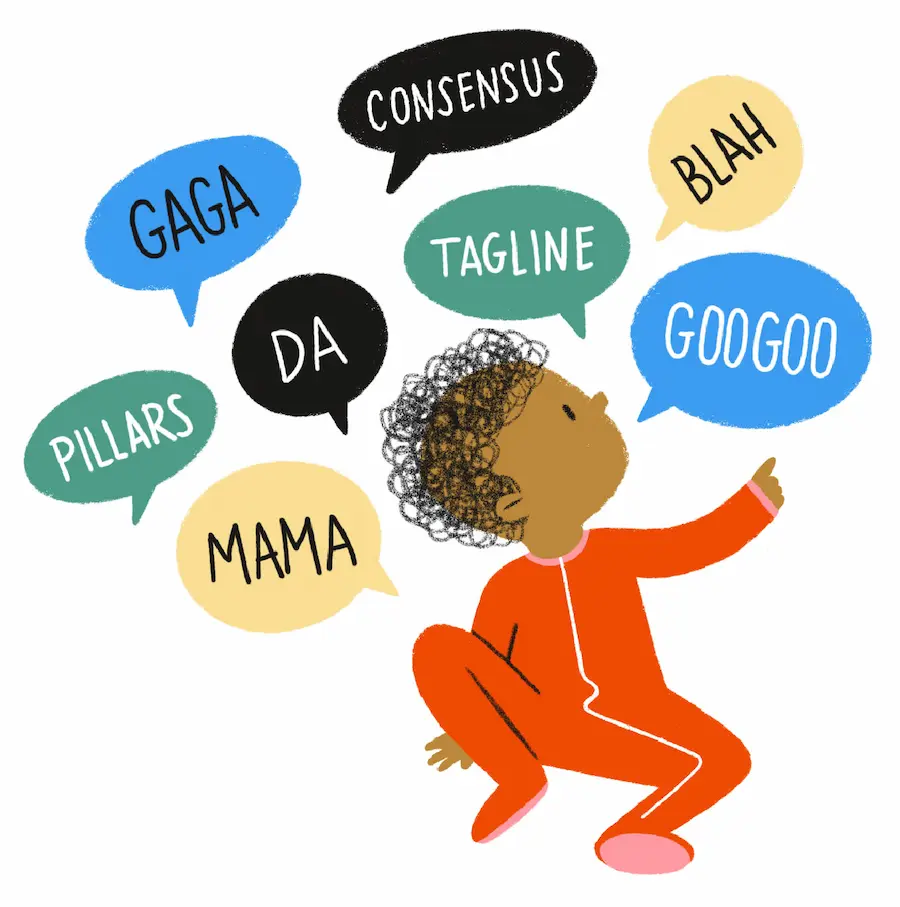What to expect when you’re expecting a brand strategy presentation
A guide to understanding and assessing your agency’s strategy work.

The wait is almost over: months of anticipation, excitement, a bit of nervousness and maybe a fair share of nausea. But all this will be coming to an end, because the day is approaching and the final product is nearly ready to be delivered. Soon, you’ll meet your new brand strategy.
To be clear, brand strategy is not a baby. But there are similarities: they can change life as you know it, and they’re a marvel to watch as they grow into their full potential. And above all, the moment when they come into the world can be one of such relief, spectacle and utter disorientation you may well forget everything you prepared for and find yourself unable to comprehend what’s in front of you, let alone evaluate it.
This is a quick guide to prepare you for that moment, and help you make the most of those first precious minutes when your brand strategy arrives—be it kicking and screaming, or calm and angelic.

Expectation #1: Jargon and more jargon
A brand strategy presentation may be filled with terminology obscure enough to remind you of flipping through the real What to Expect to learn what Kegel exercises and Braxton-Hicks contractions are all about.
It’s no secret that both the clinical and branding worlds share a bit of a vernacular problem. Strategists will readily speak of brand pillars and promises without explanation, then go straight into how this lingo facilitates a cohesive brand framework, a dynamic yet systematic brand architecture, and ultimately, comprehensive brand success!
Thing is, if you don’t understand what these terms mean and how they work, there’s little chance that they will work at all. Whether it’s your first strategy presentation or you have a growing family of brands, confusion can strike at any time. Luckily, it’s perfectly normal and completely solvable.
What to do about it:
Hold your agency accountable to speak in a language that you and your fellow stakeholders understand. If they throw out little-known terms and thereupon build an entire strategy upon them, challenge them early on to clarify and pair insider terminology with simple explanations. Your agency should be able to clearly articulate what constitutes brand strategy, and even have this on repeat at the top of every presentation. This is for your benefit, of course, but some strategists may confess it helps them keep it all straight, too.
Moreover, don’t be afraid to be the one person in the meeting who asks for clarification. If you’re unclear on something, chances are others will be too. And even if you’re already well-versed in the branding tongue, hearing an explanation can help when you have to explain it to someone else. Clarity at the outset will only help the brand strategy grow throughout your company.

Expectation #2: Multiple, complex components
Just like jargon, brand strategy presentations can contain enough figures and diagrams to give you flashbacks of assembling that crib from IKEA: brand pillars 7-10 fit into positioning columns A-E, which becomes the framework that supports the operational guardrails for market growth (see Fig. A3).
Be it a pyramid, benefits ladder or golden circle, brand strategists love using frameworks to illustrate the different parts of strategy. And they can be useful in showing the distinct purpose of each element: a brand position is not a mission statement, nor is it a vision or values—each one has a specific role and they work together as a whole. But clients can sometimes expect each part to do and say more than it should. Knowing every nuance and facet of a brand, a client may expect all those facets to be represented in every strategic element put forth.
The point of strategy, however, is to distill brand elements into distinct units and apply them all in a framework that provides a solid foundation for moving forward. Each piece will have a singular function, and when it all fits together correctly and is screwed in tight, you have a structure built to last.
What to do about it:
Step back to see the big picture and how it works together. If any one element seems lacking, clarify its usage: who it’s for, what it does, and perhaps more importantly, what it doesn’t do: “Should my brand purpose statement identify an audience? How many brand pillars are too many brand pillars? Can the brand’s essence vary by customer type?”
Your strategy team will have fielded questions like these before. So along with definitions of terms, feel free to put the framework and its individual elements to the test. With a clear understanding of what the individual parts do and don’t do, and how it all works together as a whole, you’ll be free to focus on the actual content.
Sign up for more Traina news, insights and updates.
By signing up to receive emails from Traina, you agree to our Privacy Policy. We treat your info responsibly. Unsubscribe anytime.

Expectation #3: Sharp thinking for internal eyes only
Unlike visual identity or digital experience design, in which imagery plays a large part, the bulk of brand strategy work will be presented using language and words. That being so, particular words often make for all-too-easy targets for critique, creating a superficial distraction from deeper thought into how an overall strategy aligns with your company’s goals.
The language used in strategy work can be pithy and refined enough that it may seem like messages to be used verbatim in communicating with audiences and plastered on billboards. Yet brand strategy is not advertising, nor is it even external messaging; it is an internal set of principles that explain and inform how a company wishes to be perceived in the world.
This means that word-choice details like whether a company’s primary motivation is to “show”, “reveal” or “uncover” potential isn’t really something to fixate on. But whether the action behind those three synonyms is accurate to the company’s intent—that’s worth thinking about.
Yet brand strategy is not advertising, nor is it even external messaging; it is an internal set of principles that explain and inform how a company wishes to be perceived in the world.”
What to do about it:
Focus on the ideas, not the specific words. The initial moments with your brand strategy are a precious first impression. Make sure to stay in that moment and focus on how the ideas feel to you, rather than jumping into what particular words sound good or not, or how others might respond to that language.
The baby analogy is particularly apt in this case, because when a baby first speaks, they speak in concepts, not so much words. The first time you hear “ma-ma,” or “da-da,” you share a common understanding and connection through a concept. One wouldn’t immediately address the finer points of articulation, ie. “Wouldn’t ‘Mother’ sound better there?”
Your strategist shouldn’t be speaking in baby talk, of course, but the takeaway remains: don’t get too hung up on the semantics of particular words. Strategy is behind-the-scenes, foundational guidance for your brand, a roadmap for internal eyes only. If the ideas behind the words don’t resonate, that’s a concern well worth sharing.

Expectation #4: Seemingly off-topic discussion about emotions
“Brand strategy” may seem like a rigid, cut-and-dry endeavor based strictly on intellectual rigor, but there’s a softer side—one that taps into human feelings and motivations. That’s because consumers often make decisions based on emotion, and brand strategy must account for the emotional factors that contribute toward moving your target audience to a desired action or enduring relationship.
This means strategists may ask you to embrace spirited ideas of safety, belonging, or pride in accomplishment—things that may seem completely irrelevant to, say, selling chemical reagents to lab scientists. Odd as it may seem, those strategists are seeking a foundation for the brand that builds relevance and can move it forward in the long term, as opposed to solely addressing current market conditions or immediate sales goals.
What to do about it:
Feel free to infuse some tangible into the intangible. If a presentation begins to veer too deeply into “the feels” for you, ask questions that insert your interests into the conversation. For example, if your strategists are suggesting your brand rally around a feeling and you’re more concerned with beating your competition, try asking, “How does this compare with the feelings owned by our competitors? What brands outside my industry are doing something similar?” Or, “What would my company start or stop doing based on owning this feeling?”
Also remember there is a time and place for promoting the finer points of a product, communicating functional benefits or combating the claims of competitors. Product claims and promotion fall back into that realm of advertising and external messaging, but your brand’s foundational strategy goes much deeper than that—it’s highly introspective and internal, the fundamentals that underpin it all.

Expectation #5: Losing sight of why it all matters
So you’ve translated the jargon, grasped the frameworks, looked deeper than the words and embraced the softer side of branding. But it’s all come at a cost, and now you’re as frazzled as a parent up all night tending to the cries of quintuplets.
Just like a new baby can upend a household, a new brand strategy can raise questions about what a company even does in the first place. And just like new parents can be always on edge, stakeholders facing a new strategy can find friction over the tiniest of things. What was intended to give clarity seems to have brought confusion, and perspectives once considered universal now seem at odds. If you find yourself asking, “What are we trying to accomplish here again?” then you may be asking the right question.
What to do about it:
Take some notes, take a break and don’t just “get through it.” This last point may be the most important relation of a baby to brand strategy: It. Can. Be. Messy.
Welcoming a new strategy is a massive event that transforms life and, yes, things may seem in disarray for a little while. It doesn’t help that diverse opinions will be voiced, not only on the strategy itself, but how it’s being handled, and some opinions may come from stakeholders who really shouldn’t have a voice in the subject matter, but somehow do. (Glad you came to visit, Uncle Frank, but how long are you staying?)
If evaluating your brand strategy gets to be too much, too opinionated or too obscure, clients may be tempted to force final decisions by the meeting’s end, or just move on and have the agency sort it out while shifting attention elsewhere: “So when do we see logo concepts?”
Instead, ask your agency to recap the main objectives, encourage your team to jot down some thoughts based on those objectives, and let everyone be with the new material for a while. It’s perfectly okay—and generally advisable—to let things sit for a day or two before determining what works and what doesn’t. Your brand strategy will be with you for a long time, no need to start perfecting your relationship in the first few minutes.
Welcoming your bundle of joyous brand strategy
Developing a sound, solid strategy for your brand is a collective effort—you might say it takes a village. You and your team know your company best, and just like any doctor or doula, your agency is there for you: to listen and act on your concerns, offer knowledge and perspective, and lend support and guidance throughout the process. This is what you should expect of your agency, and what you can expect from a strategy that brings your brand into a new world of opportunity and growth.
Matt Bachmann is chief strategy officer at Traina and a father to an articulate 10-year-old boy and two needy German Shepherds. Jarrett Haley is Traina’s copywriter and a dad to three children growing up way too fast.